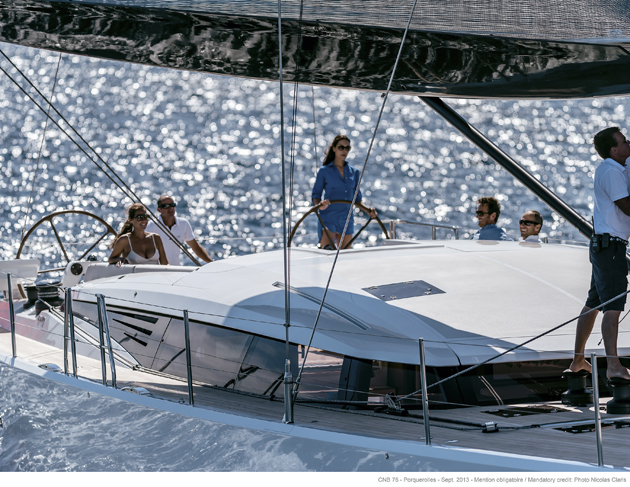The CNB 76 offers elegance, style and size for a very competitive price. Toby Hodges tests this new flagship from Groupe Beneteau, a boat made possible by her innovative build method
CNB 76 boat test – more boat for your money
The real eye-opener is that this is a production boat from leaders in that field, Groupe Beneteau. She sits in the same price sector as premium 60-65ft yachts. In fact, for the price of the CNB 76, you’d get €500,000 change from a Swan 60!
Five years ago builders CNB brought out the Bordeaux 60, 40 of which have since launched. It offered style and size for a comparatively low (under €1 million) asking price. But how have they managed to build a 76-footer that starts at €2 million (a similar sized custom boat would cost at least double that)?
With the Beneteau group’s investment, CNB devised an innovative new modular build scheme that has allowed them to construct the entire interior of the 76 outside the hull. The four modules are built to an exact tolerance, so they slot into place within millimetres of their 3D design. The benefit is simultaneous construction of hull and interior, which brings the build time down to five or six months, and so reduces cost.
The key objectives of the finished product were style, performance, a decksaloon, a proper crew area and a tender garage. After splashing the first 76 in August, CNB commendably took Leo on a six-month sea trial from Bordeaux to Turkey. Her builders and engineers joined for various legs for valuable sea-time experience.
Length = long legs
When we tested the Bordeaux 60 five years ago it was on a delivery from Barcelona to Cannes, a three-day sail to get under her skin. To its credit, CNB was keen we replicate that by giving us a lengthy spell aboard the multifaceted 76.
This is a big yacht, so it was quite daunting to be asked to pilot her off her central Palma dock within minutes of boarding. But bow and stern thrusters counteract the deficiencies of manoeuvring under power with dual rudders – and her joystick steering made life simple.
Our course from Palma Bay predominantly involved a close reach, where she maintained a consistent 10.5–11 knots in a Force 4-5. In fact, consistency is a real asset of the 76’s sailing credentials. She’ll match single-figure windspeeds up to nine knots. And with winds in the teens, she’ll sit at double figures speeds all day. Although there was only 4-6 knots of true wind for our return trip to Palma, we still managed 0.5-1 knot more than the wind speed with sheets slightly cracked.

The coachroof is a stylish and clever design. Low enough to maintain end-to-end visibility, it still provides five star views from inside the raised saloon
Heading into a short swell close-hauled, she felt stable and powerful. When heeled onto a chine, she hits a comfortably stable mode, resisting any urge to head into the wind. The dual rudders felt typically light, so helmsmen used to a single rudder may miss the associated feedback. But the upshot to the almost neutral feel of the 76 is nicely balanced sailing that’s easy on an autopilot.
The outboard helm seats are an ideal place to steer from in comfort and full visibility. Navigation information is all to hand thanks to compact pods by the wheels. When standing at these aft helms, however, I did feel a little exposed, especially in a swell, with only thigh-level guardrails behind. Apparently the central pushpit support will be raised.
With the asymmetric set, reaching speeds hit more than 11 knots, but the swell made the motion quite uncomfortable. The sail and rig pulsated between waves as they hit us on the forward quarter. Skipper Marc Renwick explained how they normally use the A5 as a versatile, easy to use furling sail for cruising and charters. A faster mastbase halyard winch would be beneficial, however, particularly when hoisting this sail.

The secret weapon? The winglets on the keel are designed to cut the vortex (like on the wing of a plane) and reduce drag
An aluminium mast comes as standard, but a Hall Spars carbon alternative is offered. We had the 3m taller performance option, which increases sail area by six or seven per cent. Even if in-mast furling is chosen, this carbon mast still apparently ends up lighter than an alloy one.
Once nestled in the invitingly protected north-facing anchorage of Cabrera, we had a good opportunity to explore the boat. There is a real superyacht feel to her deck and a clever floating theme to the styling. The jet tender was launched fuss-free in moments from the garage, paddling boards were inflated via a high-speed pump, and fins and snorkels brought out to make the most of the fading light.
I like the way stowage has been well designed to accommodate these accessories and make them easily accessible. On-deck stowage in general is very generous, if you include the large sail locker forward.






